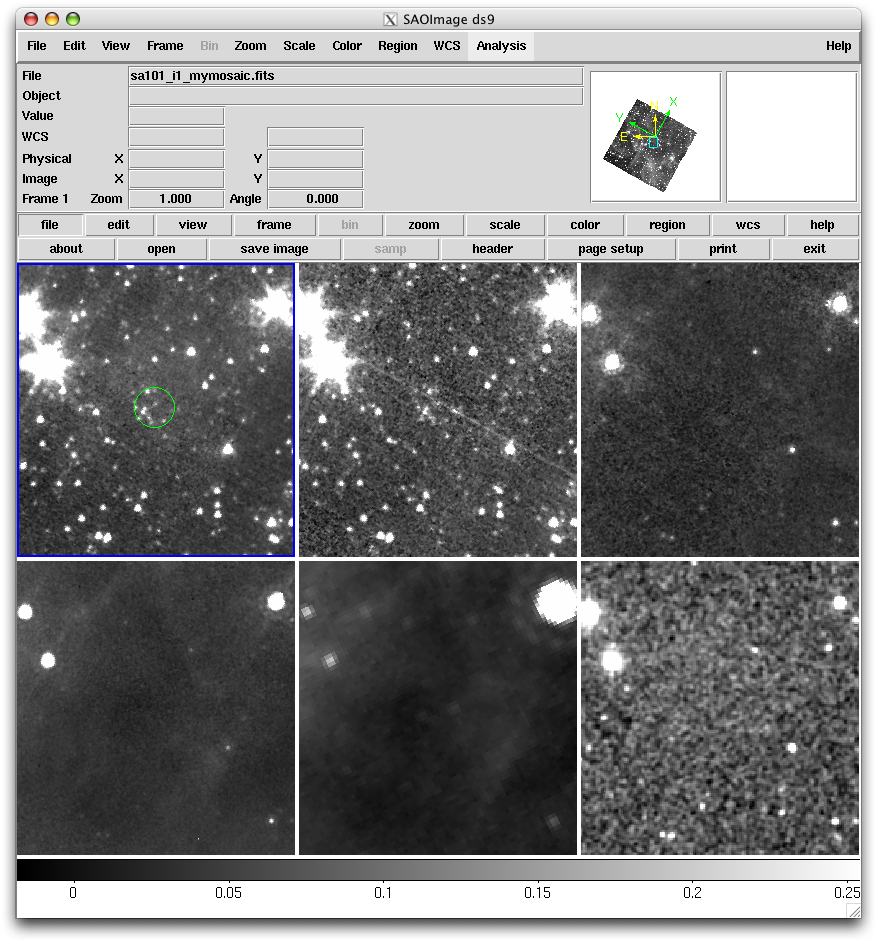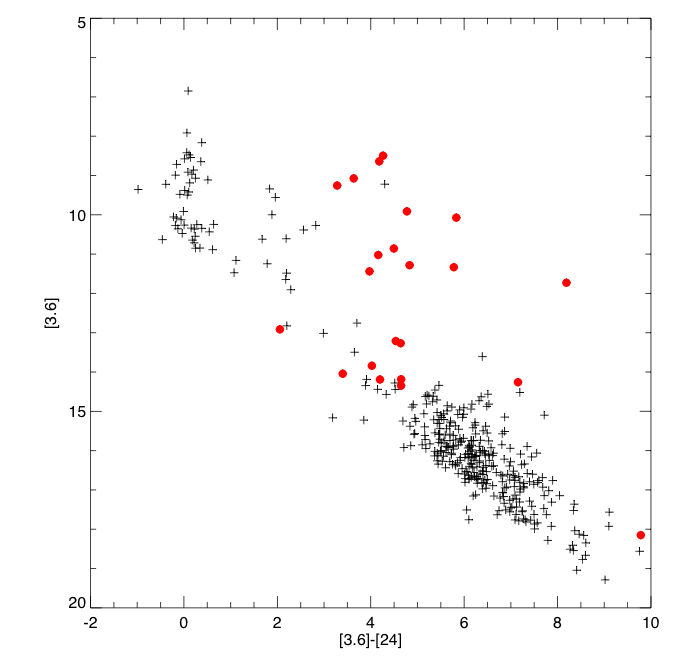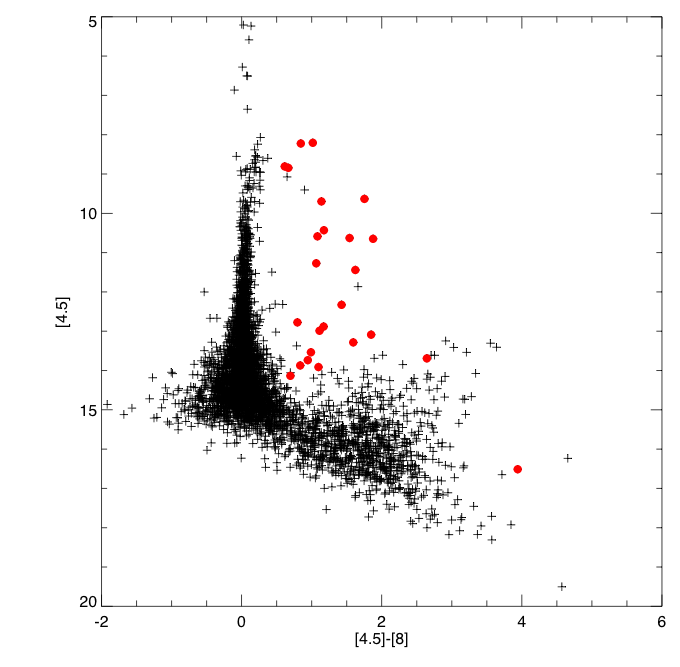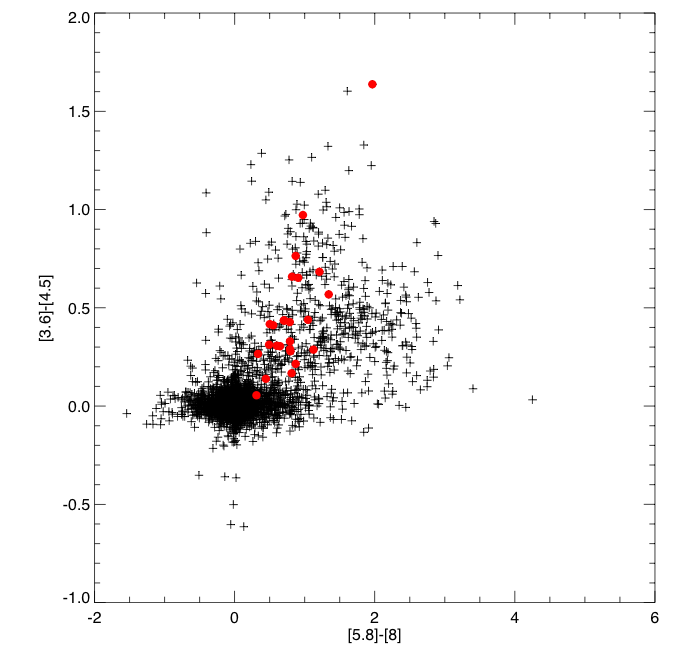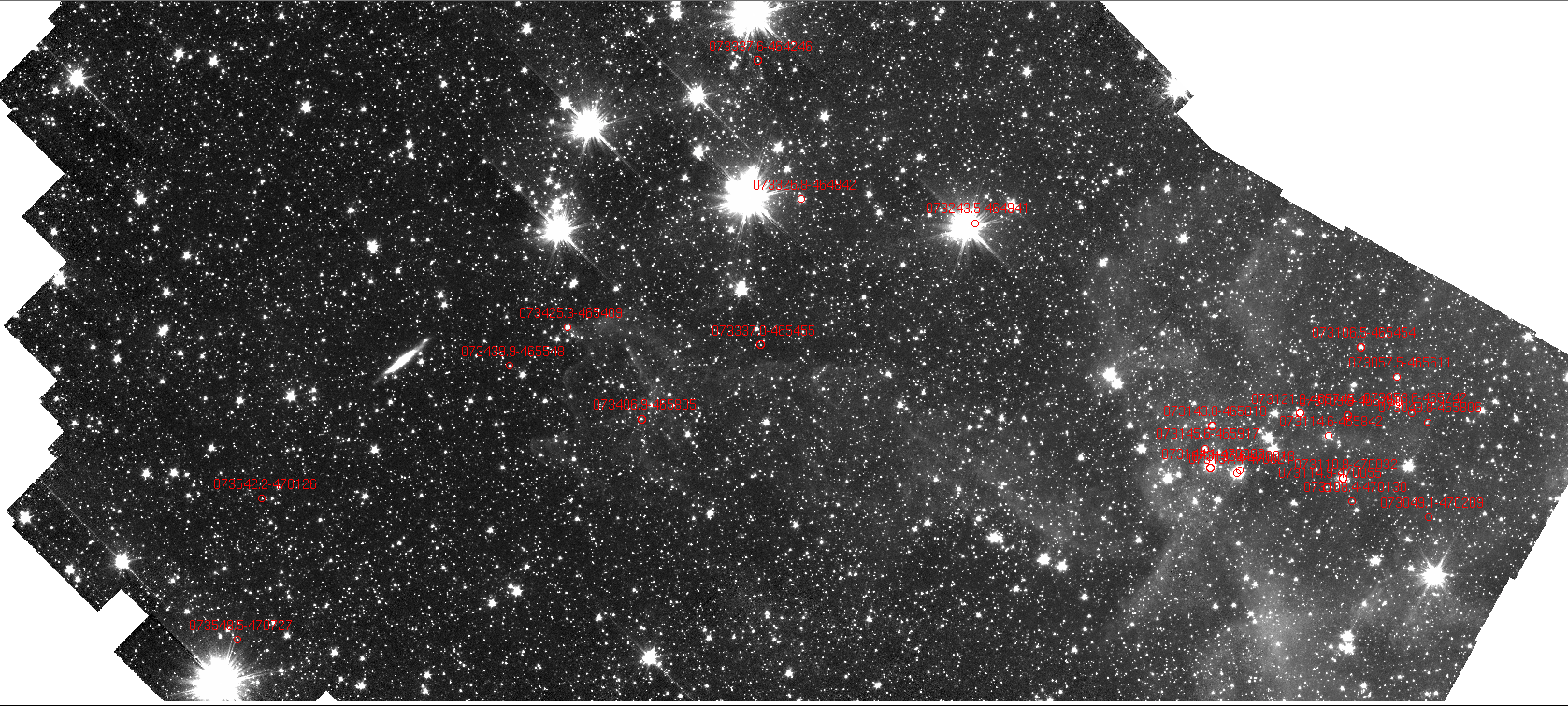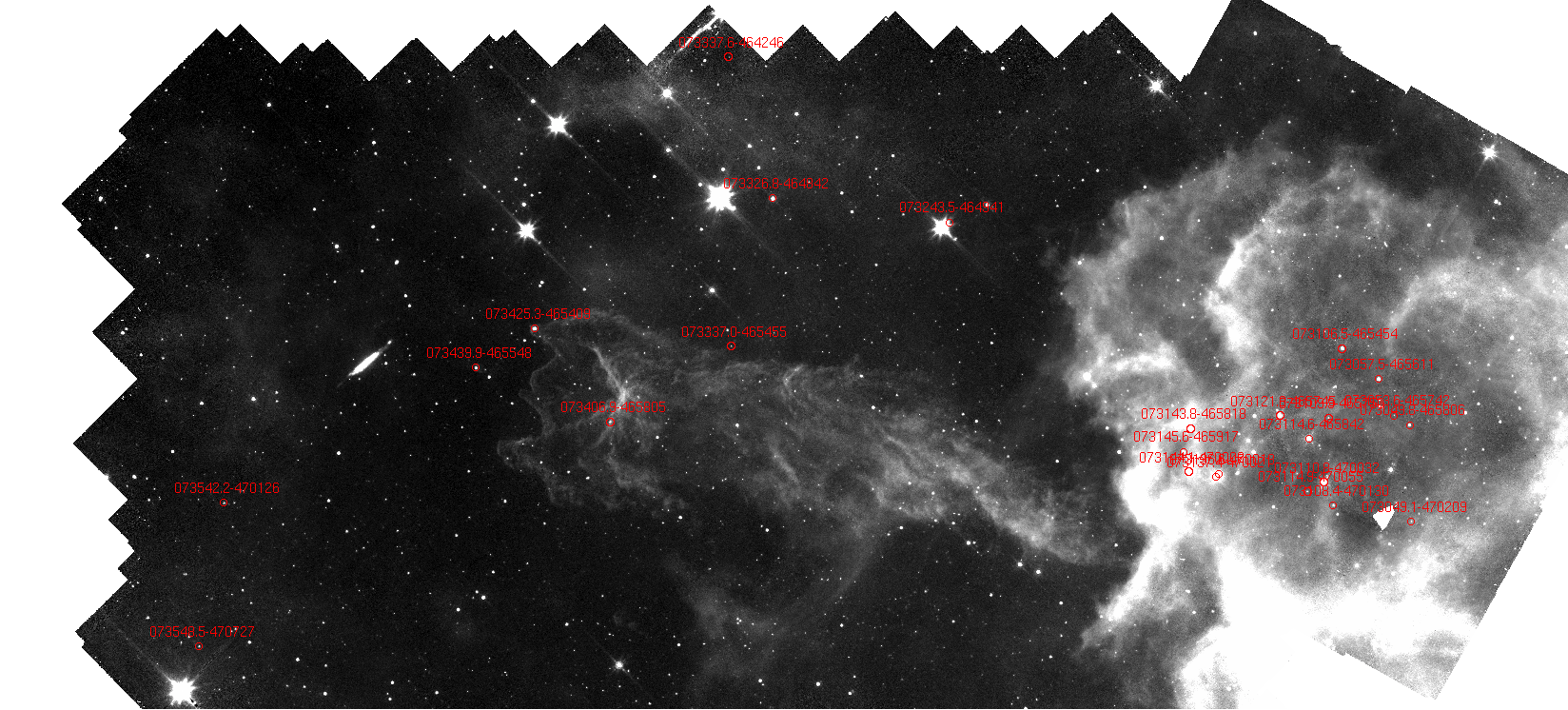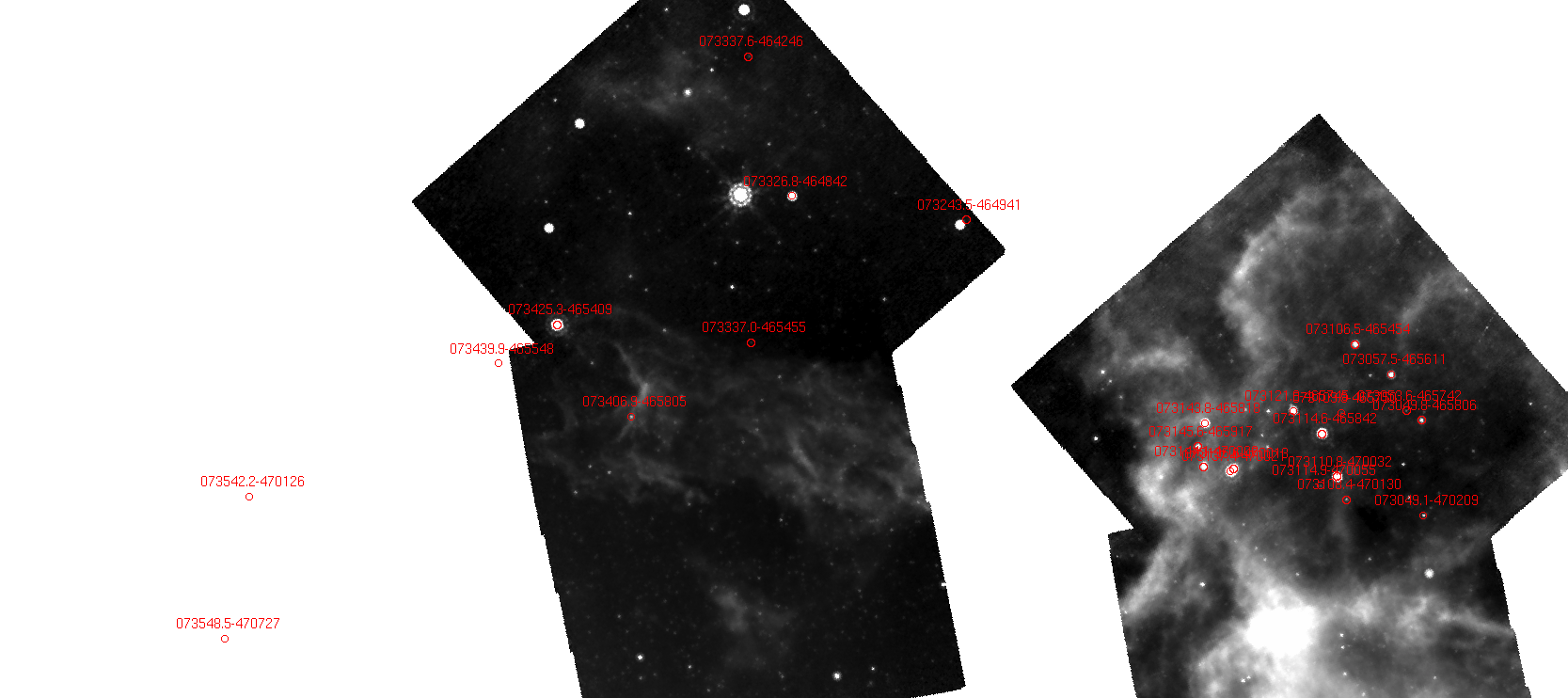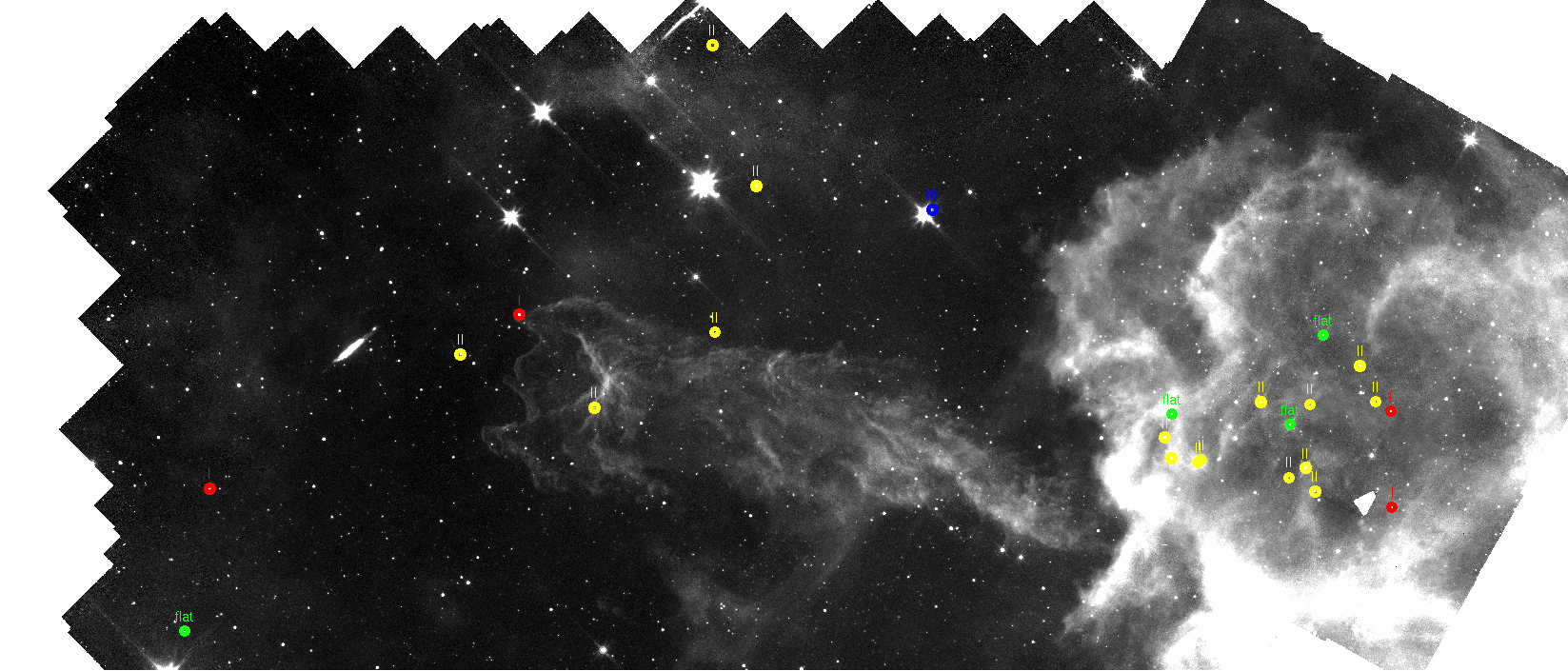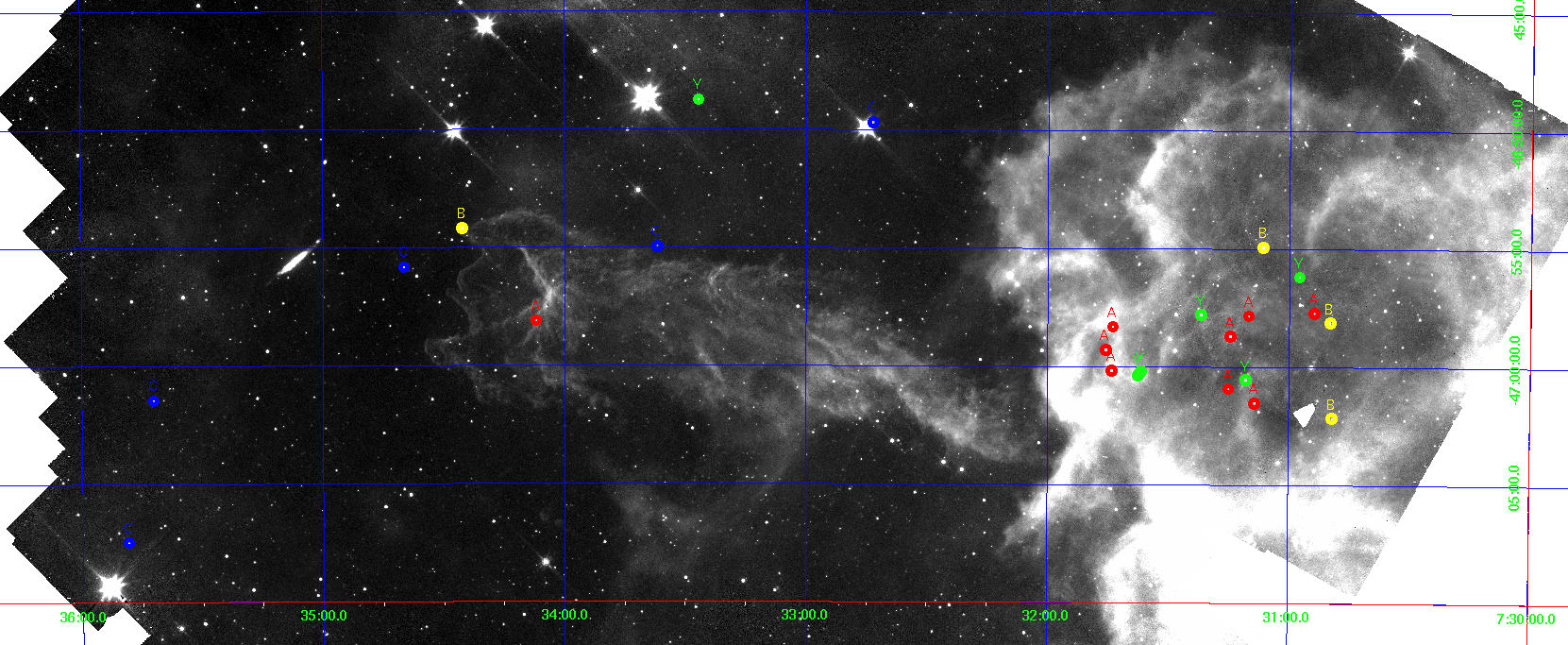Difference between revisions of "Task answer notes from luisa"
m |
(→Task 9) |
||
| (26 intermediate revisions by 2 users not shown) | |||
| Line 17: | Line 17: | ||
<font color="red">Updates from Luisa, Mon Dec 20 09:23:45 PST 2010</font>. In order to check my own photometry, I did things in two pieces. Before finding YSO candidates, I made a variety of CMD plots to make sure that the overall distribution looked like I expected it to. (See the wiki discussion of photometry for more on this.) Then, I proceeded with the analysis below, selecting YSO candidates, looking at images, and making SEDs. If you look at my notes below, you'll see that I made notes where there was possible or likely photometry problems. I then did a more detailed check of the YSO candidate photometry. (This is an iterative process. It always is.) Here are more notes on that. | <font color="red">Updates from Luisa, Mon Dec 20 09:23:45 PST 2010</font>. In order to check my own photometry, I did things in two pieces. Before finding YSO candidates, I made a variety of CMD plots to make sure that the overall distribution looked like I expected it to. (See the wiki discussion of photometry for more on this.) Then, I proceeded with the analysis below, selecting YSO candidates, looking at images, and making SEDs. If you look at my notes below, you'll see that I made notes where there was possible or likely photometry problems. I then did a more detailed check of the YSO candidate photometry. (This is an iterative process. It always is.) Here are more notes on that. | ||
| − | WARNING -- in the process of doing this, i rediscovered the | + | WARNING -- in the process of doing this, i rediscovered the fact that we should not be using the big merged mosaic at MIPS for photometry, because Russ had to normalize it to get it to work. This shouldn't matter for making pretty pictures, but it will matter a lot for photometry! I went back to my smaller mosaics for the photometry at MIPS bands. |
First, a raw check of the photometry, then notes on what I was looking for/expecting to find. | First, a raw check of the photometry, then notes on what I was looking for/expecting to find. | ||
| Line 61: | Line 61: | ||
*073114.6-465842 | *073114.6-465842 | ||
*073114.9-470055 - noted in image inspection as faint m1 - | *073114.9-470055 - noted in image inspection as faint m1 - | ||
| − | *073121.8-465745 - because of multiple source issue, i'm expecting rotten photom here - actually well-matched except i3; m1 a little off. prob original better. | + | *073121.8-465745 - because of multiple source issue, i'm expecting rotten photom here - actually well-matched except i3; m1 a little off. prob original better. (NB: "original" means inheriting some photometry from one of the dropped sources!) |
| − | *073136.6-470013 - nothing should be unusual here, but irac photom wildly different all bands except i2, and m1 very different too. what? | + | *073136.6-470013 - nothing should be unusual here, but irac photom wildly different all bands except i2, and m1 very different too. what? looking at SED, original photometry is better. |
| − | *073137.4-470021 - i1i3 both very different. | + | *073137.4-470021 - i1i3 both very different. what? looking at SED, original photometry is better. |
*073143.8-465818 | *073143.8-465818 | ||
*073144.1-470008 - noted in image inspection as could be messy irac phot due to source proximity - got different i1 on redo. but this is faint obj next to bright obj. high error measurement anyway. m1 a little different, keep original. | *073144.1-470008 - noted in image inspection as could be messy irac phot due to source proximity - got different i1 on redo. but this is faint obj next to bright obj. high error measurement anyway. m1 a little different, keep original. | ||
| Line 77: | Line 77: | ||
*073548.5-470727 | *073548.5-470727 | ||
| − | Summary of photometry JUST changes/best fluxes to use; if not listed, keep orig fluxes | + | Summary of photometry JUST changes/best fluxes to use; if not listed, keep orig fluxes... note that after all that, most of the fluxes are just fine!! but look at how much nicer the SEDs look in these few cases. Sorry, but I only had time to make one example for you -- see examplenewsed.gif below.. |
| − | *073049.8-465806 - use new m1 | + | *073049.8-465806 - use new m1 (10253 +/- 426 uJy, 7.11 +/- 0.05 mag) |
| − | *073057.5-465611 - use new m1 | + | *073057.5-465611 - use new m1 (20345 +/- 844 uJy, 6.36 +/- 0.05 mag) |
| − | *073109.9-465750 - use new m1. | + | *073109.9-465750 - use new m1 (942 +/- 66 uJy, 9.70 +/- 0.08 mag) |
| − | *073110.8-470032 - new IRAC fluxes look much better. use those. | + | *073110.8-470032 - new IRAC fluxes look much better. use those. [[media:examplenewsed.gif]] (i1: 98177+/- 4918 uJy, 8.64+/-0.05 mag; i2: 92211 +/- 4620 uJy, 8.22 +/- 0.05 mag; i3 unchanged; i4: 71660 +/- 3591 uJy, 7.38 +/- 0.05 mag) |
| − | + | *073121.8-465745 - take the JHK and m1 fluxes accidently assigned to 073121.8-465744 and assign them here. | |
| − | * | + | *073243.5-464941 - no change, except can add m1 LIMIT ( <324 uJy, >10.86 mag) |
| − | *073243.5-464941 - no change, except can add m1 LIMIT | ||
| + | My final, best list of [[media:justysos+opt.cat.tbl_20dec.txt|fluxes]] and [[media:ysoseds_20dec.pdf|SEDs]]. NOTE THAT there are limits now in the file of fluxes. Be careful if/when you import it to xls. | ||
=Task 2= | =Task 2= | ||
| Line 270: | Line 270: | ||
''TASK: [...] make some color-mag and color-color diagrams'' | ''TASK: [...] make some color-mag and color-color diagrams'' | ||
| − | + | Look at the IC2118 paper for specific examples and ideas. I suggest for the poster (and for that matter the paper) that we make CMDs and color-color diagrams with the final list of YSO candidates highlighted. Here are some of mine: [[media:task6plots.pdf]]. | |
| + | |||
| + | Here are my favorites, e.g., I would put these on the poster if I were first author, and some suggested words: | ||
| + | |||
| + | [[image:task6cmd1.png]] | ||
| + | |||
| + | [3.6] vs. [3.6]-[24] for the entire catalog (crosses) and our final set of YSO candidates (red dots). Photospheres (e.g., stars without disks) are found near [3.6]-[24]~0, and galaxies are found at the red and faint (lower right) end of the plot. The structure of the overall distribution going from upper left to lower right is primarily an artifact of the mis-matched depth of the survey (e.g., 3.6 um reaches substantially fainter sources than 24 um). YSO candidates are red and bright, e.g., largely in the upper right of the diagram. Nearly all of our final YSO candidates are in this region of the diagram where (in similar plots) other YSO candidates in other clusters are found. One of our candidates is quite faint, and may represent a faint legitimate YSO, or a background galaxy. | ||
| + | |||
| + | [[image:task6cmd2.png]] | ||
| + | |||
| + | [4.5] vs. [4.5]-[8] for the entire catalog (crosses) and our final set of YSO candidates (red dots). As for the earlier figure, photospheres (e.g., stars without disks) are found near [4.5]-[8]~0, and galaxies are found at the red and faint (lower right) end of the plot. Here again, the lack of points in the extreme lower left is primarily an artifact of the survey itself -- 4.5 um reaches fainter objects than 8 um. YSO candidates are red and bright, e.g., largely in the upper right of the diagram. Nearly all of our final YSO candidates are in this region of the diagram where (in similar plots) other YSO candidates in other clusters are found. Again, one of our candidates is quite faint, and may represent a faint legitimate YSO, or a background galaxy. | ||
| + | |||
| + | [[image:task6cmd3.png]] | ||
| + | |||
| + | [3.6]-[4.5] vs. [5.8]-[8] for the entire catalog (crosses) and our final set of YSO candidates (red dots). Photospheres (e.g., stars without disks) are found near a color of 0 on both axes. YSOs are generally red on both axes. All of our YSO candidates fall in this regime. The rest of the objects that fall in this regime have colors in other bands strongly suggesting that they are contaminants, not YSO candidates. | ||
=Task 7= | =Task 7= | ||
| Line 276: | Line 290: | ||
''TASK: [...] make SEDs'' | ''TASK: [...] make SEDs'' | ||
| − | I sent around examples before, including ones with the optical included. In order to incorporate the optical data, you need the wavelengths and zeropoints of the optical bands, which I sent in email. | + | I sent around examples before, including ones with the optical included. In order to incorporate the optical data, you need the wavelengths and zeropoints of the optical bands, which I sent in email. (look for something from 28 October) |
<font color="red">UPDATE from Luisa Fri Dec 17 16:06:58 PST 2010</font>: | <font color="red">UPDATE from Luisa Fri Dec 17 16:06:58 PST 2010</font>: | ||
| Line 311: | Line 325: | ||
*073542.2-470126 meh. no 24um possible, weird that no 2mass or optical. weak candidate because of lack of data. | *073542.2-470126 meh. no 24um possible, weird that no 2mass or optical. weak candidate because of lack of data. | ||
*073548.5-470727 meh. no 24um possible, weird that no 2mass or optical. weak candidate because of lack of data. | *073548.5-470727 meh. no 24um possible, weird that no 2mass or optical. weak candidate because of lack of data. | ||
| + | |||
| + | Take this information, and go check the photometry. (go back up to Task 1 to keep reading.) | ||
| + | |||
| + | <font color="red">UPDATE Mon Dec 20 11:03:00 PST 2010</font> after redoing phot: | ||
| + | SO, total tallies are: | ||
| + | 25 YSO candidates! 6 independent rediscoveries of previously-identified YSOs and 19 entirely new YSO candidates -- among them, based on available data, 10 reasonably high-confidence YSO candidates, 4 mid-grade confidence, and 5 low-grade confidence. We will need to obtain spectra of all of the new ones to confirm or reject them as YSOs. | ||
| + | |||
| + | *073049.1-470209 new mid-grade | ||
| + | *073049.8-465806 new mid-grade | ||
| + | *073053.6-465742 new hi-grade | ||
| + | *073057.5-465611 re-discovery of previously-known YSO | ||
| + | *073106.5-465454 new mid-grade | ||
| + | *073108.4-470130 new hi-grade | ||
| + | *073109.9-465750 new hi-grade | ||
| + | *073110.8-470032 re-discovery of previously-known YSO | ||
| + | *073114.6-465842 new hi-grade | ||
| + | *073114.9-470055 new hi-grade | ||
| + | *073121.8-465745 re-discovery of previously-known YSO | ||
| + | *073136.6-470013 re-discovery of previously-known YSO | ||
| + | *073137.4-470021 re-discovery of previously-known YSO | ||
| + | *073143.8-465818 new hi-grade | ||
| + | *073144.1-470008 new hi-grade | ||
| + | *073145.6-465917 new hi-grade | ||
| + | *073243.5-464941 new low-grade | ||
| + | *073326.8-464842 re-discovery of previously-known YSO | ||
| + | *073337.0-465455 new low-grade | ||
| + | *073337.6-464246 new hi-grade | ||
| + | *073406.9-465805 new hi-grade | ||
| + | *073425.3-465409 new mid-grade | ||
| + | *073439.9-465548 new low-grade | ||
| + | *073542.2-470126 new low-grade | ||
| + | *073548.5-470727 new low-grade | ||
=Task 8= | =Task 8= | ||
| Line 316: | Line 362: | ||
''TASK: [...] SED slopes'' | ''TASK: [...] SED slopes'' | ||
| − | + | This is what I get, for the final set of YSO candidates. What I did was fit a line to all available points (not limits) between (and including) K and 24 microns. | |
| + | object slope class | ||
| + | 073049.1-470209 1.70 I | ||
| + | 073049.8-465806 0.35 I | ||
| + | 073053.6-465742 -0.84 II | ||
| + | 073057.5-465611 -0.91 II | ||
| + | 073106.5-465454 -0.25 flat | ||
| + | 073108.4-470130 -0.87 II | ||
| + | 073109.9-465750 -0.80 II | ||
| + | 073110.8-470032 -0.95 II | ||
| + | 073114.6-465842 -0.27 flat | ||
| + | 073114.9-470055 -1.09 II | ||
| + | 073121.8-465745 -1.33 II | ||
| + | 073136.6-470013 -1.18 II | ||
| + | 073137.4-470021 -0.99 II | ||
| + | 073143.8-465818 -0.30 flat | ||
| + | 073144.1-470008 -0.96 II | ||
| + | 073145.6-465917 -1.19 II | ||
| + | 073243.5-464941 -1.96 III | ||
| + | 073326.8-464842 -0.83 II | ||
| + | 073337.0-465455 -1.27 II | ||
| + | 073337.6-464246 -1.10 II | ||
| + | 073406.9-465805 -0.88 II | ||
| + | 073425.3-465409 1.20 I | ||
| + | 073439.9-465548 -0.47 II | ||
| + | 073542.2-470126 0.38 I | ||
| + | 073548.5-470727 -0.14 flat | ||
| + | |||
| + | That's a total of 4 Class I candidates, 16 Class II candidates, 4 flat candidates, and 1 class III candidate. | ||
=Task 9= | =Task 9= | ||
| Line 323: | Line 397: | ||
hint: use region files and ds9. | hint: use region files and ds9. | ||
| + | |||
| + | Here are some quick-and-dirty things I did. Most of you have already figured out that most of the surviving YSOs are on the far right (West) of the image. [[media:cg4region.reg.txt|my region file if you want to copy it]]-- save this file to disk and change the extension to ".reg" to use it in ds9. | ||
| + | |||
| + | [[image:ysosonirac1.png]] | ||
| + | |||
| + | YSO candidates on IRAC-1 | ||
| + | |||
| + | [[image:ysosonirac4.png]] | ||
| + | |||
| + | YSO candidates on IRAC-4 | ||
| + | |||
| + | [[image:ysosonmips1.png]] | ||
| + | |||
| + | YSO candidates on MIPS-1 | ||
| + | |||
| + | [[image:ysobyclassoni4.png]] | ||
| + | |||
| + | YSO candidates by SED class on IRAC-4. I was hoping that this would show all the objects of a particular class clustered. It doesn't. This means we probably have contaminants in our list! :) | ||
| + | |||
| + | [[image:ysobygradeoni4.png]] | ||
| + | |||
| + | YSO candidates by grade (previously known YSO = "Y", then A, B, C in order from highest to lowest confidence). THIS one is nice. Shows that our highest-confidence ones ARE clustered. Good news. | ||
| + | |||
| + | =Task 10= | ||
| + | |||
| + | ''TASK: [...] something to do with the galaxy.'' | ||
| + | |||
| + | I searched in [http://nedwww.ipac.caltech.edu/ NED] by position. I found that it is also called ESO 257- G 019. [http://nedwww.ipac.caltech.edu/cgi-bin/nph-objsearch?objname=ESO+257-+G+019&extend=no&hconst=73&omegam=0.27&omegav=0.73&corr_z=1&out_csys=Equatorial&out_equinox=J2000.0&obj_sort=RA+or+Longitude&of=pre_text&zv_breaker=30000.0&list_limit=5&img_stamp=YES search results]. | ||
Latest revision as of 08:02, 21 December 2010
Contents
Task 0
I really hoped that I had successfully reached everyone with some content in June, or at least that people would have time to go back and go through it all again. In June, my last words to you all were to go home, find a quiet few hours, and go through the wiki again with your notes. I knew we'd gone through a lot, very fast, but I also knew that you all had been doing things right (=correctly, confidently, independently) while you were here, and that it was going to take some review with the materials on the wiki to get it all straight. But it seems that I didn't successfully reach everyone, and apparently no one had time to go through it again. I will try to make sure next year's teams come later than June so that the visit is closer to getting tasks done and farther from vacations...
If you are really feeling terribly underwater here, really, please, sit down with the Working with CG4+SA101 page. I promise, there are TONS more words and instructions and step-through-it exercises there. When I say I am proceeding as if you are familiar with the stuff from before, I really do mean it... If absolutely the only thing you get out of this is successfully actually learning just one or two of the tasks from the summer and never getting into this, then that's fine, it's still more than you knew a year ago.
Task 1
TASK: spot-check some of my photometry
Still needs some spot checks. Have only heard from Russ that maybe one is wrong. Have not put in the time to resolve this one.
NB: SPOT CHECKS does not mean DO EVERY SINGLE ONE. It means do enough to assure yourself that (a) you know how to do it, and (b) that I did it right in at least a few cases. HOWEVER, having said that, in another few steps, you'll need to investigate each one separately in as many images as possible, so it is probably worth LOCATING the objects in a few different Spitzer frames, even if you don't do the PHOTOMETRY. Are they all point sources?
Updates from Luisa, Fri Dec 17 15:28:53 PST 2010. The way that I would go about this task is inexorably intertwined with investigating the images at each band, which was technically task 4. I am pretty sure that my photometry is ok for most of the sources in the entire field, and most of the YSO candidates. For the source that got corrected midstream (the one previously-known YSO with the corrected coords) for some reason does not have a measured MIPS flux in my photometry. This is weird, and something that I ultimately want to track down. There are also various kinks and wiggles in the SEDs of the YSO candidates that I want to check.
Updates from Luisa, Mon Dec 20 09:23:45 PST 2010. In order to check my own photometry, I did things in two pieces. Before finding YSO candidates, I made a variety of CMD plots to make sure that the overall distribution looked like I expected it to. (See the wiki discussion of photometry for more on this.) Then, I proceeded with the analysis below, selecting YSO candidates, looking at images, and making SEDs. If you look at my notes below, you'll see that I made notes where there was possible or likely photometry problems. I then did a more detailed check of the YSO candidate photometry. (This is an iterative process. It always is.) Here are more notes on that.
WARNING -- in the process of doing this, i rediscovered the fact that we should not be using the big merged mosaic at MIPS for photometry, because Russ had to normalize it to get it to work. This shouldn't matter for making pretty pictures, but it will matter a lot for photometry! I went back to my smaller mosaics for the photometry at MIPS bands.
First, a raw check of the photometry, then notes on what I was looking for/expecting to find.
Here is a table -- for each (surviving) object, I've tabulated my original photometry and a check I did. the check is redoing the photometry at the position we are reporting for the object in question. excel version of this information
cat num i1orig i1check diff i2orig i2check diff i3orig i3check diff i4orig i4check diff m1orig m1check diff 073049.1-470209 18.15 18.15 -0.00 16.51 16.51 -0.00 14.54 14.53 0.01 12.57 12.57 -0.00 8.37 8.33 0.04 073049.8-465806 14.26 14.28 -0.02 13.69 13.44 0.25 12.39 12.40 -0.00 11.05 11.06 -0.01 8.77 7.11 1.66 073053.6-465742 14.18 14.18 -0.00 13.87 13.88 -0.01 13.53 13.53 0.00 13.04 13.06 -0.02 9.53 9.57 -0.03 073057.5-465611 10.86 10.86 -0.00 10.43 10.44 -0.00 10.04 10.05 -0.01 9.26 9.27 -0.01 8.76 6.36 2.40 073106.5-465454 11.28 11.28 0.00 10.63 10.63 -0.01 10.00 10.01 -0.01 9.09 9.10 -0.01 6.45 6.31 0.14 073108.4-470130 13.21 13.22 -0.01 12.88 12.89 -0.01 12.50 12.51 -0.01 11.71 11.72 -0.01 8.68 8.89 -0.22 073109.9-465750 14.35 14.35 -0.00 13.91 13.92 -0.01 13.52 13.54 -0.02 12.82 12.80 0.02 -9.00 9.70 -18.70 073110.8-470032 8.75 8.64 0.11 8.37 8.22 0.14 7.88 7.89 -0.01 7.65 7.38 0.27 4.46 4.34 0.12 073114.6-465842 10.07 10.07 0.00 9.63 9.64 -0.01 8.93 8.94 -0.01 7.88 7.87 0.01 4.24 4.11 0.13 073114.9-470055 13.84 13.84 -0.00 13.54 13.54 -0.00 13.20 13.21 -0.01 12.55 12.57 -0.02 9.82 9.65 0.17 073121.8-465745 9.26 9.26 -0.01 8.84 8.86 -0.02 8.73 8.36 0.36 8.18 8.16 0.01 5.97 5.75 0.22 073136.6-470013 9.07 9.41 -0.34 8.81 8.87 -0.06 8.53 8.66 -0.13 8.19 8.66 -0.47 5.44 4.94 0.49 073137.4-470021 8.50 8.17 0.33 8.21 8.13 0.08 7.98 7.74 0.24 7.19 7.19 0.00 4.23 4.12 0.11 073143.8-465818 11.33 11.25 0.08 10.65 10.62 0.03 9.98 9.97 0.02 8.77 8.78 -0.01 5.55 5.46 0.10 073144.1-470008 11.02 10.79 0.23 10.59 10.59 -0.01 10.21 10.23 -0.02 9.50 9.52 -0.02 6.86 6.65 0.21 073145.6-465917 11.44 11.42 0.02 11.27 11.25 0.02 11.02 11.01 0.01 10.21 10.22 -0.01 7.47 7.00 0.46 073243.5-464941 12.91 12.82 0.10 12.78 12.76 0.02 12.42 12.17 0.26 11.98 12.01 -0.03 -9.00 10.86 -19.86 073326.8-464842 9.91 9.91 -0.00 9.70 9.70 -0.01 9.43 9.44 -0.01 8.56 8.58 -0.02 5.14 5.03 0.10 073337.0-465455 14.04 14.04 -0.00 13.74 13.74 -0.01 13.39 13.40 -0.00 12.79 12.79 -0.00 10.64 10.06 0.58 073337.6-464246 14.19 14.20 -0.01 14.14 14.15 -0.02 13.75 13.78 -0.03 13.44 13.55 -0.11 9.99 9.49 0.51 073406.9-465805 13.27 13.27 -0.00 12.99 12.99 -0.01 12.67 12.69 -0.01 11.88 11.91 -0.03 8.63 8.76 -0.13 073425.3-465409 11.73 11.75 -0.02 11.44 11.29 0.15 10.94 10.93 0.01 9.82 9.88 -0.06 3.54 3.39 0.15 073439.9-465548 12.99 12.99 -0.01 12.33 12.34 -0.01 11.72 11.73 -0.01 10.90 10.92 -0.02 073542.2-470126 14.06 14.06 -0.00 13.09 13.09 -0.00 12.21 12.23 -0.01 11.24 11.26 -0.02 073548.5-470727 14.05 14.05 -0.00 13.28 13.29 -0.01 12.56 12.57 -0.01 11.69 11.71 -0.02
Notes on objects:
- 073049.1-470209 -
- 073049.8-465806 - noted in SED inspection as check i4/m1 - i4 well matched, i2 weirdly off, and m1 is in fact off.
- 073053.6-465742 - noted in image inspection as faint m1 - m1 ok.
- 073057.5-465611 - noted in SED inspection as check i4/m1 - m1 is in fact off.
- 073106.5-465454
- 073108.4-470130 - m1 a little off. original phot probably more accurate.
- 073109.9-465750 - noted in SED inspection as where is m1 - now have an m1.
- 073110.8-470032 - noted in SED inspection as check i4 - wildly different all bands except i3. what?
- 073114.6-465842
- 073114.9-470055 - noted in image inspection as faint m1 -
- 073121.8-465745 - because of multiple source issue, i'm expecting rotten photom here - actually well-matched except i3; m1 a little off. prob original better. (NB: "original" means inheriting some photometry from one of the dropped sources!)
- 073136.6-470013 - nothing should be unusual here, but irac photom wildly different all bands except i2, and m1 very different too. what? looking at SED, original photometry is better.
- 073137.4-470021 - i1i3 both very different. what? looking at SED, original photometry is better.
- 073143.8-465818
- 073144.1-470008 - noted in image inspection as could be messy irac phot due to source proximity - got different i1 on redo. but this is faint obj next to bright obj. high error measurement anyway. m1 a little different, keep original.
- 073145.6-465917 - m1 different. weird, keep original.
- 073243.5-464941 - noted in image inspection as could be messy phot due to source proximity - actually well matched except for i3, but this is faint obj next to bright obj. high error measurement anyway. have an upper limit for m1 now (note that number given there is actually an UPPER LIMIT!).
- 073326.8-464842
- 073337.0-465455 - noted in image inspection as faint m1 - SED inspection implies check m1 - m1 is different, but original probably better because faint.
- 073337.6-464246 - noted in image inspection as faint m1 - got i4 a little different - m1 is different, but original probably better because faint.
- 073406.9-465805
- 073425.3-465409 - got i2 a little different.
- 073439.9-465548
- 073542.2-470126
- 073548.5-470727
Summary of photometry JUST changes/best fluxes to use; if not listed, keep orig fluxes... note that after all that, most of the fluxes are just fine!! but look at how much nicer the SEDs look in these few cases. Sorry, but I only had time to make one example for you -- see examplenewsed.gif below..
- 073049.8-465806 - use new m1 (10253 +/- 426 uJy, 7.11 +/- 0.05 mag)
- 073057.5-465611 - use new m1 (20345 +/- 844 uJy, 6.36 +/- 0.05 mag)
- 073109.9-465750 - use new m1 (942 +/- 66 uJy, 9.70 +/- 0.08 mag)
- 073110.8-470032 - new IRAC fluxes look much better. use those. media:examplenewsed.gif (i1: 98177+/- 4918 uJy, 8.64+/-0.05 mag; i2: 92211 +/- 4620 uJy, 8.22 +/- 0.05 mag; i3 unchanged; i4: 71660 +/- 3591 uJy, 7.38 +/- 0.05 mag)
- 073121.8-465745 - take the JHK and m1 fluxes accidently assigned to 073121.8-465744 and assign them here.
- 073243.5-464941 - no change, except can add m1 LIMIT ( <324 uJy, >10.86 mag)
My final, best list of fluxes and SEDs. NOTE THAT there are limits now in the file of fluxes. Be careful if/when you import it to xls.
Task 2
TASK: look at the short lists of YSO candidates.
FAQ: wondering which files to use? *ysocand.tbl.
which are duplicates? there are several that are rediscovered between the tiles. i'll leave it to you to identify the specific ones. from the entire catalogs, there are more than 1000 objects in common between the frames.
are there any that should have been rediscovered but were not? no, that is -- if it was in both tiles, then it was identified as a YSO in both independent detections.
Task 3
TASK: did we rediscover any of the [previously-identified YSOs]?
yes, yes we did. i get 5, or possibly 6; see next item.
are there any in the maps that we did not rediscover? yes, possibly 1.
why did we not rediscover them? (e.g., do they not have any IR excess? if not, why were they identified as young before? can you think of a reason for this discrepancy, if it exists?) I HAVE NOT COMPLETED THIS TASK but i can tell you that some strongly contributing reasons we did not recover one of them is because (a) it requires a larger than "usual" coordinate shift to match it to one of the catalog items (is that a true match? are there other sources in that region it could match to?); (b) for the closest match, we only have 2 irac bands in the catalog, which means that the gutermuth method could never have recovered it. (why do we have only 2 bands? is it on the edge? it it saturated? i don't know; i am leaving this to you.)
UPDATE 23 NOV copy from email.
Mark is working on making SEDs, and had a question re: the source matching with the previously identified objects:
mark says: I was able to match up 5 previous identified Reipurth & Pettersson sources, but there's a final sixth that I'm having trouble matching (see below). Any ideas?
- CG-Halpha 4? 073121.8-465943 112.84104 -46.995456
- CG-Halpha 4? 073121.8-465744 112.84107 -46.96228
- CG-Halpha 4? 073121.9-465746 112.841607 -46.962904
hm. certainly when I did this before, there was one source where I wasn't sure if I found the right match or not; it required a relatively large shift to find the match. ok, here is what i get for the matching.
- cg-halpha 1 -- 667" from anything. no match.
- 2 -- 1.45" from 073057.5-465611
- 3 -- 1.23" from 073110.8-470032
- 4 -- 1.66" from 073121.8-465943
- 5 -- 0.89" from 073136.6-470013
- 6 -- 0.82" from 073137.4-470021
- 7 -- 1.10" from 073326.8-464842
- 8 -- >10,000 arcsec from anything, no match
- PHalpha 92 -- >58,000 arcsec from anything, no match
Now, remember, this is a blind matching, which the computer is doing without my intervention. 1.66" is pretty far, compared to the other coordinates in the list (it's the largest one of all the matches). BUT, the next closest thing is 6.2" away, much further than the rest.
So, let's go look at the images. (NB: For one of the tasks below, i made a 5-min YouTube video to demonstrate something awfully close to the following steps.) I asked IRSA's finder chart service (http://irsa.ipac.caltech.edu/applications/FinderChart/ -- linked from the fall work page also) to give me DSS and 2MASS images at this location: 112.84133 -46.995872 and in the DSS images as well as the 2MASS images, there's nothing really very bright at this location, which already makes me suspicious -- the prior optical surveys were very shallow, so they should have only found the bright sources. The fact that there is no bright source here is worriesome.
Here is a screenshot of what I get when I look at the IRAC1234+MIPS1 image of this region, and the last pane is 2MASS J (I think) for comparison. The green circle in the first panel is centered on the position for CG4-Halpha 4; the other panes are aligned to cover the same area, in the same orientation. The objects at the location given for CG4-Halpha 4 are faint even in 3.6 um! And really nothing is there at all in irac-3 or 4. It MIGHT be there in mips1, but wow that's a stretch. And it's definitely not there in 2MASS.
SO, my conclusion is that we don't know exactly what object Reipurth and Petersson were really looking at when they recorded CG4-Halpha 4. It could have been that one of these faint guys really was whoppingly bright at the time that they observed it -- after all, young stars do vary with time. BUT whatever it was is either not really at this location (e.g., they screwed up the coordinates), or perhaps there was an error in transcription.
I went back to the Reipurth and Pettersson paper, and it reports in 1950 coordinates: 7:29:54.1, -46:51:19 when i convert this to J2000, I get 7:31:21.95, -46:57:45.1 note that this is -46:57:45, not -46:59:45. That's an easy error to make, especially if transcribing something handwritten!
With that new position, the closest match is 0.71" away from 073121.8-465745. At this location in the images, there's something whoppingly bright at the Spitzer bands, and it's seen at MIPS-24 too, though for some reason this object is missing a flux at 24 um in our catalog. The object apears to be saturated or somehow other compromised at 8um, so there's no flux there either. I can see it in the 2MASS images, though it is missing a 2MASS flux in our catalog as well -- perhaps it is saturated.
OK, so the implications of this are: (1) we need to update (correct) the list of previously known sources in at least 2 places on the wiki, and in all of your own notes and spreadsheets. (2) someone needs to go manually measure the flux densities for him at least at 24um. (2a -- i need to track down why there is no mips-24 flux (and for that matter, JHK and 8um) for this object in my catalog) (3) the current best ysocandidate list DOES NOT ALREADY HAVE this guy included -- it's in the master catalog, but it didn't have a 24 um flux there either. The previous ysocandidate list does have 073121.8-465943, which I had manually added on the basis of the fact that it appeared (blindly) to match the position for the previously known object. HOWEVER, now we know that this is erroneously included due to this position error, and it should be dropped from our list of YSOs. (4) Now we know the answer to the question I posed in the Fall Work page for task3 -- did we recover all of the previously known objects in our fields? no. Are there any we did not recover? yes, one, because of missing fluxes.
Task 4
TASK: for each of the YSO candidates, [investigate them at other bands]
i guarantee you that at least 3 of the YSOs should be dropped because they are not really stars. not telling you which ones! you go figure this out ...
Update from Luisa Fri Dec 17 15:33:39 PST 2010: ITEM 1: I made a video that shows how to use the IRSA finder chart service plus ds9 to examine the images for each object. See the 5-min YouTube video (this version has the watermark removed!).
ITEM 2: The YSO candidate list is starting with 30 objects. I went through each of the Spitzer bands that we have, looking at each of the YSO candidates. Here are my notes on what I see in the Spitzer images. I did not look in all the 2MASS images. Did you find anything different? The spatial resolution at 2MASS is comparable to IRAC-1, so 2MASS should not reveal many galaxies that we did not suspect from the IRAC image, but it might reveal other useful information (such as "i can see the object here, so why do we not have a JHK flux for it in the catalog?"). No notes from me in the below means that there was nothing unusual or remarkable at i1234 or m1.
SSTiau name 073049.1-470209 073049.8-465806 073053.6-465742 very faint m1, but probably there. 073057.5-465611 073106.5-465454 073108.4-470130 073109.9-465750 073110.8-470032 073114.6-465842 073114.9-470055 very faint m1, but probably there. 073121.8-465744 multiple srcs on top of one, probably not unique detections DROP 073121.8-465745 multiple srcs on top of one, probably not unique detections. this is best centered, probably best fluxes obtained here. 073121.9-465746 multiple srcs on top of one, probably not unique detections DROP 073136.6-470013 073137.4-470021 073143.8-465818 073144.1-470008 src is offset from core of bright star in i1,i2. real? in i3 can clearly see that it's really another source. computer wins! 073145.6-465917 073243.5-464941 stuck in muck from bright star in i1,i2,i3. fluxes prob hi error. even in i4, hard to tell if real source. what does SED look like? i can't see it in m1. 073326.8-464842 073337.0-465455 very faint m1, but probably there. 073337.6-464246 very faint m1, but probably there. 073406.9-465805 073425.3-465409 BOOMING bright m1. 073439.9-465548 off edge m1 (no fluxes possible.) 073501.1-465442 middle of gal, not true pt src much less YSO. offedge m1. DROP 073504.7-465514 middle of gal, not true pt src much less YSO. offedge m1. DROP 073508.1-465544 middle of gal, not true pt src much less YSO. offedge m1. DROP 073542.2-470126 offedge m1. 073548.5-470727 near diffraction spike i1, prob ok. offedge m1.
PROBLEM CHILDREN:
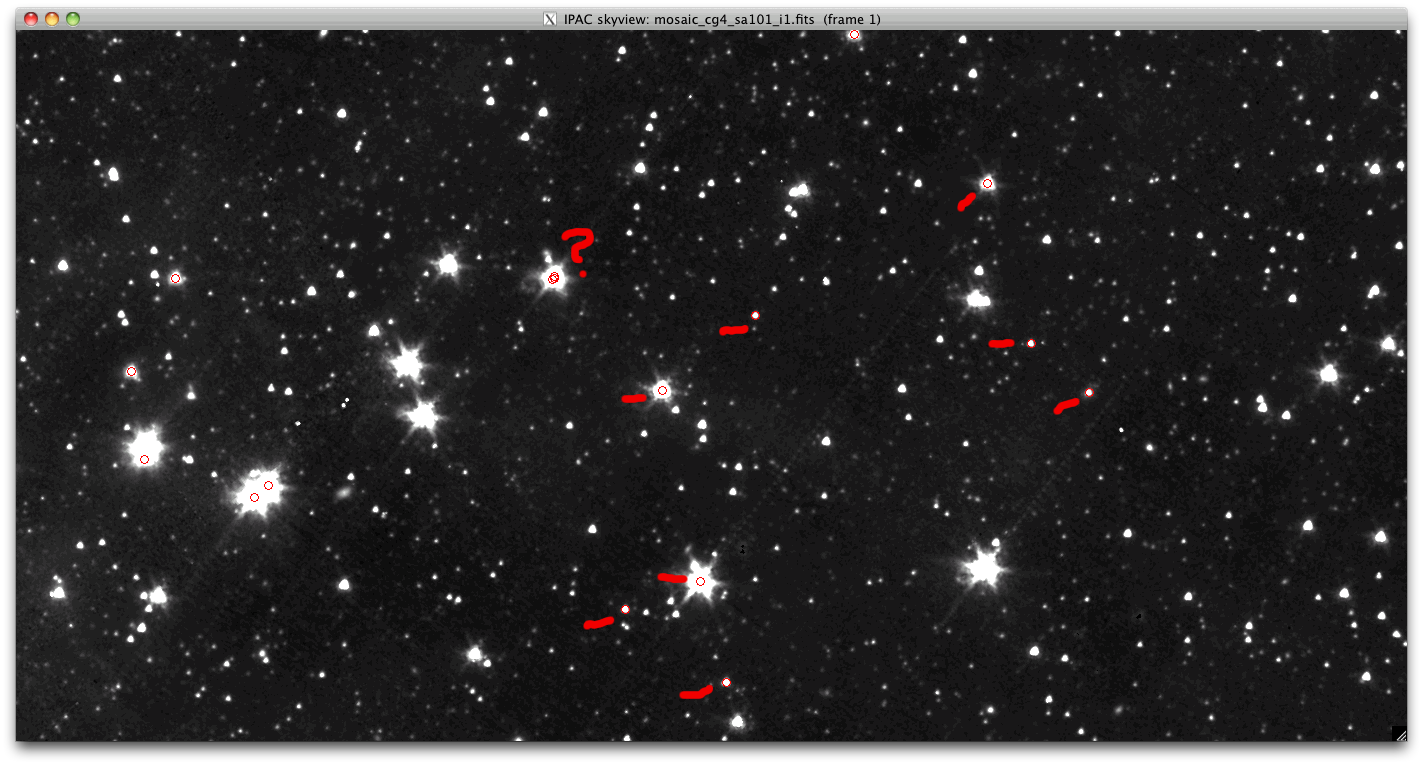 Look at how the red circles are nicely centered on the sources, even the fainter ones, in most cases in this zoom-in, except for that cluster of 3 sources on top of the bright object. (I've added some large red lines to draw your eye towards some of the little red circles centered on the YSO candidates.) Something hiccupped here in that one case -- the computer often has problems with the brightest sources because the PSF is a complicated shape when it gets really bright. The most likely best measurement of the real source is the one best centered on the source. Drop the other two sources as false sources.
Look at how the red circles are nicely centered on the sources, even the fainter ones, in most cases in this zoom-in, except for that cluster of 3 sources on top of the bright object. (I've added some large red lines to draw your eye towards some of the little red circles centered on the YSO candidates.) Something hiccupped here in that one case -- the computer often has problems with the brightest sources because the PSF is a complicated shape when it gets really bright. The most likely best measurement of the real source is the one best centered on the source. Drop the other two sources as false sources.
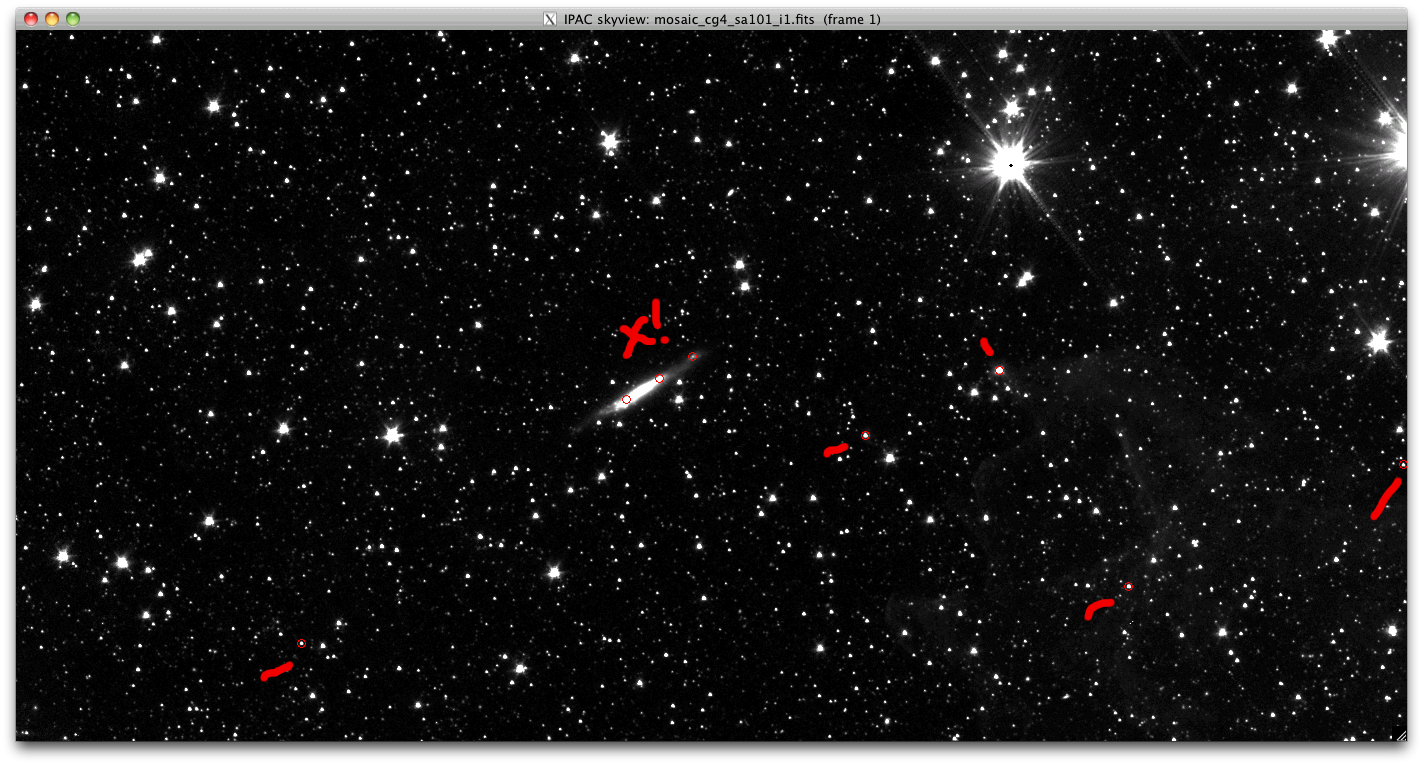 Here again, look at how the red circles are nicely centered on the sources -- I've added some large red lines to draw your eye towards the little red circles centered on the YSO candidates. But there seems to be three "sources" within the galaxy. Here, the computer has been fooled by local brightness maxima in the galaxy. These objects are not single young stars. They may indeed be large star-forming complexes in the other galaxy (they seem to have the right colors), but they are not single point sources, so they're not young stars in *our* galaxy. Drop them from the list.
Here again, look at how the red circles are nicely centered on the sources -- I've added some large red lines to draw your eye towards the little red circles centered on the YSO candidates. But there seems to be three "sources" within the galaxy. Here, the computer has been fooled by local brightness maxima in the galaxy. These objects are not single young stars. They may indeed be large star-forming complexes in the other galaxy (they seem to have the right colors), but they are not single point sources, so they're not young stars in *our* galaxy. Drop them from the list.
I thought that 073144.1-470008 was going to turn out to be another problem child, but inspection at the longer bands (i3 and 4) reveals that the computer is correct, there really is a distinct source there.
SO now that we've dropped 5 things off the list, the running YSO candidate list is now down to 25 objects.
Task 5
TASK: for the new YSO candidates[...]go get the optical
OK, so this was WAY WAY WAY harder than I thought it would have been. there were TONS of duplicates within the optical catalog, as well as objects with no photometry at all. I did this merging and have emailed around a merged catalog.
Task 6
TASK: [...] make some color-mag and color-color diagrams
Look at the IC2118 paper for specific examples and ideas. I suggest for the poster (and for that matter the paper) that we make CMDs and color-color diagrams with the final list of YSO candidates highlighted. Here are some of mine: media:task6plots.pdf.
Here are my favorites, e.g., I would put these on the poster if I were first author, and some suggested words:
[3.6] vs. [3.6]-[24] for the entire catalog (crosses) and our final set of YSO candidates (red dots). Photospheres (e.g., stars without disks) are found near [3.6]-[24]~0, and galaxies are found at the red and faint (lower right) end of the plot. The structure of the overall distribution going from upper left to lower right is primarily an artifact of the mis-matched depth of the survey (e.g., 3.6 um reaches substantially fainter sources than 24 um). YSO candidates are red and bright, e.g., largely in the upper right of the diagram. Nearly all of our final YSO candidates are in this region of the diagram where (in similar plots) other YSO candidates in other clusters are found. One of our candidates is quite faint, and may represent a faint legitimate YSO, or a background galaxy.
[4.5] vs. [4.5]-[8] for the entire catalog (crosses) and our final set of YSO candidates (red dots). As for the earlier figure, photospheres (e.g., stars without disks) are found near [4.5]-[8]~0, and galaxies are found at the red and faint (lower right) end of the plot. Here again, the lack of points in the extreme lower left is primarily an artifact of the survey itself -- 4.5 um reaches fainter objects than 8 um. YSO candidates are red and bright, e.g., largely in the upper right of the diagram. Nearly all of our final YSO candidates are in this region of the diagram where (in similar plots) other YSO candidates in other clusters are found. Again, one of our candidates is quite faint, and may represent a faint legitimate YSO, or a background galaxy.
[3.6]-[4.5] vs. [5.8]-[8] for the entire catalog (crosses) and our final set of YSO candidates (red dots). Photospheres (e.g., stars without disks) are found near a color of 0 on both axes. YSOs are generally red on both axes. All of our YSO candidates fall in this regime. The rest of the objects that fall in this regime have colors in other bands strongly suggesting that they are contaminants, not YSO candidates.
Task 7
TASK: [...] make SEDs
I sent around examples before, including ones with the optical included. In order to incorporate the optical data, you need the wavelengths and zeropoints of the optical bands, which I sent in email. (look for something from 28 October)
UPDATE from Luisa Fri Dec 17 16:06:58 PST 2010: Mark Legassie managed to make some SEDs. The midwestern folks asked for me to make some notes on what I thought about each of the SEDs.
- 073049.1-470209 very steep! could be very embedded source, could be xgal. need spectrum to be sure. leave in our list as a mid-grade confidence object
- 073049.8-465806 wow, that's a weird one. Either the m1 flux is wrong (too low by a lot) or this might be an xgal. the high flux at 8um compared to the other bands could suggest a high-mass young star or a complex of hi-mass YSOs in a star-forming galaxy. i didn't note anything weird about the 24 um data in my anaylsis above, so there is nothing screamingly obvious suggesting that the photometry is wildly wrong. need a spectrum.
- 073053.6-465742 nice. this is a keeper.
- 073057.5-465611 also nice. possible that the 24 is a little low or the 8 is a little high. we may wish to go back and check the photometry on those two points. i didn't note anything strange at 8 or 24 in the data, so there's nothing screamingly obvious suggesting that the photometry is wildly wrong.
- 073106.5-465454 hm. broader than I would expect for a star. could be a real yso, could be xgal. need spectrum.
- 073108.4-470130 nice. this is a keeper.
- 073109.9-465750 pretty nice. where is the 24um flux? it is in the image, so i will go back and see if i can get a flux estimate to add in to the SED.
- 073110.8-470032 nice. 8um is maybe a little low. would be useful to go back and check this flux.
- 073114.6-465842 pretty nice. need spectrum to be sure.
- 073114.9-470055 pretty nice. plain photosphere is steeper than this, so it has excesses.
- 073121.8-465744 SHOULD BE DROPPED as dupe! the JHK and m1 fluxes accidently assigned to him should go to the next object.
- 073121.8-465745 this is the legitimate object of this trio. the optical is appropriately assigned. not sure why no 8um flux -- probably take 5.8 and 8 um flux from prior obj, just by looking at shape of SED.
- 073121.9-465746 SHOULD BE DROPPED as dupe! note that the optical from the prior source is identical here -- the optical got assigned to both srcs. note that the IRAC bands here are systematically lower than the above source -- it's not centered on the source, so it's not catching all the flux, so it's artificially low.
- 073136.6-470013 nice. keeper.
- 073137.4-470021 nice. keeper.
- 073143.8-465818 nice. also a keeper.
- 073144.1-470008 nice. a keeper. (plain photosphere is steeper than this.)
- 073145.6-465917 nice, keeper.
- 073243.5-464941 this one has no m24, and really isn't in that image. this one is stuck in the muck of a bright star, and might have an excess only at 5.8 and 8 um (look, it seems to curve up). weak, marginal candidate. even getting a spectrum would be hard given proximity of bright star.
- 073326.8-464842 nice, keeper.
- 073337.0-465455 small excess if any. very faint at 24um. weak candidate only because weak excess.
- 073337.6-464246 nice, keeper
- 073406.9-465805 nice, keeper.
- 073425.3-465409 wow, this one is still just really really odd to my eye. it is clearly really and truly there and booming bright at m24. this may be the most interesting object in the set, because it's very embedded but clearly very bright. would like to get a spectrum, but may be too embedded to do anything from the ground!! list as mid-grade confidence jsut because we don't have any strong evidence that it's NOT a bg galaxy except for the 24um brightness.
- 073439.9-465548 meh. no 24um possible. doesn't scream YSO to me, but maybe jsut because there are not a lot of points. we have stronger candidates. need spectrum.
- 073501.1-465442 DROP
- 073504.7-465514 DROP
- 073508.1-465544 DROP
- 073542.2-470126 meh. no 24um possible, weird that no 2mass or optical. weak candidate because of lack of data.
- 073548.5-470727 meh. no 24um possible, weird that no 2mass or optical. weak candidate because of lack of data.
Take this information, and go check the photometry. (go back up to Task 1 to keep reading.)
UPDATE Mon Dec 20 11:03:00 PST 2010 after redoing phot: SO, total tallies are: 25 YSO candidates! 6 independent rediscoveries of previously-identified YSOs and 19 entirely new YSO candidates -- among them, based on available data, 10 reasonably high-confidence YSO candidates, 4 mid-grade confidence, and 5 low-grade confidence. We will need to obtain spectra of all of the new ones to confirm or reject them as YSOs.
- 073049.1-470209 new mid-grade
- 073049.8-465806 new mid-grade
- 073053.6-465742 new hi-grade
- 073057.5-465611 re-discovery of previously-known YSO
- 073106.5-465454 new mid-grade
- 073108.4-470130 new hi-grade
- 073109.9-465750 new hi-grade
- 073110.8-470032 re-discovery of previously-known YSO
- 073114.6-465842 new hi-grade
- 073114.9-470055 new hi-grade
- 073121.8-465745 re-discovery of previously-known YSO
- 073136.6-470013 re-discovery of previously-known YSO
- 073137.4-470021 re-discovery of previously-known YSO
- 073143.8-465818 new hi-grade
- 073144.1-470008 new hi-grade
- 073145.6-465917 new hi-grade
- 073243.5-464941 new low-grade
- 073326.8-464842 re-discovery of previously-known YSO
- 073337.0-465455 new low-grade
- 073337.6-464246 new hi-grade
- 073406.9-465805 new hi-grade
- 073425.3-465409 new mid-grade
- 073439.9-465548 new low-grade
- 073542.2-470126 new low-grade
- 073548.5-470727 new low-grade
Task 8
TASK: [...] SED slopes
This is what I get, for the final set of YSO candidates. What I did was fit a line to all available points (not limits) between (and including) K and 24 microns.
object slope class 073049.1-470209 1.70 I 073049.8-465806 0.35 I 073053.6-465742 -0.84 II 073057.5-465611 -0.91 II 073106.5-465454 -0.25 flat 073108.4-470130 -0.87 II 073109.9-465750 -0.80 II 073110.8-470032 -0.95 II 073114.6-465842 -0.27 flat 073114.9-470055 -1.09 II 073121.8-465745 -1.33 II 073136.6-470013 -1.18 II 073137.4-470021 -0.99 II 073143.8-465818 -0.30 flat 073144.1-470008 -0.96 II 073145.6-465917 -1.19 II 073243.5-464941 -1.96 III 073326.8-464842 -0.83 II 073337.0-465455 -1.27 II 073337.6-464246 -1.10 II 073406.9-465805 -0.88 II 073425.3-465409 1.20 I 073439.9-465548 -0.47 II 073542.2-470126 0.38 I 073548.5-470727 -0.14 flat
That's a total of 4 Class I candidates, 16 Class II candidates, 4 flat candidates, and 1 class III candidate.
Task 9
TASK: [...] 3-color images with sources indicated
hint: use region files and ds9.
Here are some quick-and-dirty things I did. Most of you have already figured out that most of the surviving YSOs are on the far right (West) of the image. my region file if you want to copy it-- save this file to disk and change the extension to ".reg" to use it in ds9.
YSO candidates on IRAC-1
YSO candidates on IRAC-4
YSO candidates on MIPS-1
YSO candidates by SED class on IRAC-4. I was hoping that this would show all the objects of a particular class clustered. It doesn't. This means we probably have contaminants in our list! :)
YSO candidates by grade (previously known YSO = "Y", then A, B, C in order from highest to lowest confidence). THIS one is nice. Shows that our highest-confidence ones ARE clustered. Good news.
Task 10
TASK: [...] something to do with the galaxy.
I searched in NED by position. I found that it is also called ESO 257- G 019. search results.
